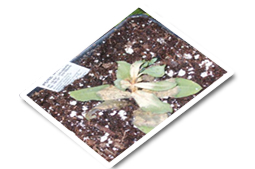
What is Botrytis:
There are over 50 different pathogenic species of Botrytis. In horticulture, Botrytis cinerea is the most common and has the largest host range. Botrytis cinerea (Botrytis from Ancient Greek meaning “grapes” plus the Neo-Latin suffix –itis for disease) is a necrotrophic fungus that affects many plant species.
Its common names include gray or brown mold, bacterial soft rot, blossom blight, leaf blight, stem canker, crown rot, and damping off or seedling blight. Botrytis is estimated to cause more economic loss in ornamentals than any other disease.
It affects a wide range of plants, including ornamentals, fruits and vegetables. Especially susceptible are wine grapes, strawberries, and flowers with thick succulent petals, such as begonias, peonies and geraniums. It also commonly affects African violets, dahlias, pansies, snapdragons, zinnias, chrysanthemums and many others.
Identifying Botrytis:
Botrytis mainly affects the tender tissues of plants, such as flowers, fruits and seedlings. It can enter the plant through weakened or injured tissues, and aging or distressed tissues. Lower, shaded sections of a plant are usually the first to show signs of Botrytis infection.
Botrytis infection usually begins as a water-soaked browning area regardless of the tissue affected. After the initial browning, tan to gray fuzzy mold develops on or around the brown tissue. The rest of the plant may begin to show signs of infection such as yellowing leaves or buds.
How Botrytis Spreads:
Botrytis persists in the greenhouse as spores on living or dead plants, or in infested growing media (which is why it is important to always use new growing media and, if you are re-using pots, to sterilize them appropriately). When environmental conditions are right (i.e. temperatures around 59 oF with a relative humidity (RH) > 90%), the dormant spores will germinate into active spores, called “conidia”. Conidia are dispersed in large numbers by air currents or overhead watering.
Preventing Botrytis Outbreaks:
Botrytis is considered an environmental disease, meaning it can only develop when environmental conditions are conducive to its growth. Humidity is the largest contributing variable to Botrytis. As long as the humidity is kept below 85%, Botrytis is unlikely to develop. The other contributing environmental factor is temperature. Botrytis grows most rapidly in lower temperatures with high humidity. The best prevention is to maintain humidity below 85%, by increased forced circulation or an increased amount of heat. If possible, proper bench spacing is also essential in reducing humidity in the canopy.
Treatment Options for Botrytis:
As with many greenhouse pathogens, prevention is the key to avoiding Botrytis. Keeping greenhouses, containers and equipment clean, using new growing media and removing any dying or dead plant material by placing faded or blighted flowers, leaves or entire plants in a paper bag and discarding are the best options.
Most chemicals for the treatment of Botrytis control are preventative. They will help control the spread of the disease, but are not likely to cure it once it takes hold of a plant (which is why environmental and cultural controls are so important).
If a grower has a particularly susceptible crop, they may want to consider a fungicide application prior to an upcoming period of extreme cloudy, cool weather. It is extremely important to read and follow the label of any fungicide before applying as many of the products for Botrytis can cause phytotoxicity, stunting or chlorosis.
Summary:
In summary, Botrytis cinerea is one of the most common and costly fungal diseases of greenhouse crops. Management of environmental conditions, such as regulation of temperature, humidity and leaf wetness duration, and sound cultural practices are the best ways to prevent disease development.


